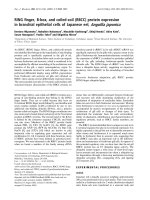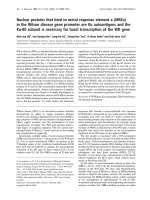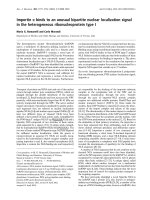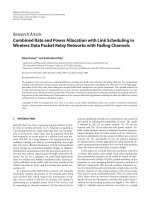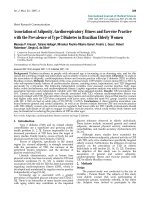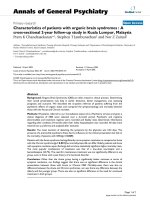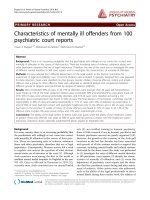Báo cáo y học: "Characteristics of HIV-infected women and factors associated with HCV seropositivity in the Republic of Georgia" doc
Bạn đang xem bản rút gọn của tài liệu. Xem và tải ngay bản đầy đủ của tài liệu tại đây (251.23 KB, 6 trang )
RESEARC H Open Access
Characteristics of HIV-infected women and factors
associated with HCV seropositivity in the Republic
of Georgia
Nikoloz Chkhartishvili
1*
, Louise-Anne McNutt
2
, Perry F Smith
3
and Tengiz Tsertsvadze
1,4
Abstract
Background: The aim of this study was to describe the extent of the HIV epidemic among women in the
Republic of Georgia and to identify factors associated with HCV co-infection in this population.
Findings: All women aged ≥18 years who were diagnosed with HIV between 1989 and 2006 were identified
through the National HIV/AIDS surveillance database. Medical records were reviewed for demographic
characteristics, risk factors and HCV serostatus. A total of 249 women were identified. Only 4% declared injection
drug use (IDU); sex work was reported by 9%. Substantial risk factors were identified among the women’s sexual
partners, nearly 69% of whom were IDUs, 84% were HIV positive and 66% HCV positive. Seventeen percent of
women were seropositive for HCV. Factors significantly associated with HCV seropositivity in bivariate analyses
among non-IDU women were partner IDU+ [Prevalence ratio (PR): 4.5 (95% CI: 1.4, 14.2)], and partner HCV+ [PR: 7.2
(95% CI: 1.8, 29.5)].
Conclusions: The HIV epidemic in the Republic of Georgia is closely tied to the IDU community. Evidence-based
interventions targeting IDU and partners of IDU are urgently required to halt the spread of the HIV epidemic in the
country.
Findings
TheNewlyIndependentStates(NIS)ofEurasiahavethe
highest rates of HIV infection in the region [1,2]. The
HIV epidemic here has been closely linked with the
socioeconomic and political upheava ls of the early 1990s
and the collapse of the Soviet Union. The emergence of
drug markets and injection drug use (IDU) is now the
major driver of the epidemic in the region [3,4]. The bur-
geoning IDU population was accompanied by an explo-
sive spread of hepatitis C virus (HCV) and HIV; today,
the IDU population is almost universally infected with
HCV and the majority is co-infected with HIV [5-7].
Formerly part of the Soviet Union, Georgia is an inde-
pendent nation with a population of about 4.5 million.
Compared to other NIS, Georgia’s HIV epidemic started
later and grew more slowly. The first case of HIV was
reported in 1989; as of December 31, 2006, a cumulative
1,156 HIV cases had been reported. Nearly 78% of cases
are men and 22% women. Although the estimated HIV
prevalence in Ge orgia is low (< 0.1%), the rate of new
infections has risen each year (see Figure 1). Among
men, approximately 80% of cases are attributable to
IDU. The vast majority of HIV positive women (93%)
were exposed through heterosexual contact.
Similar to other countries in the region, the spread of
HCV infection in Georgia was partially associated with
theriseinIDU.Multiplestudieshavefoundstrong
ass ociations between male gender, IDU and HCV infec-
tion. While HIV prevalence in IDUs is relatively low
(2.2%), HCV infection is com mon (70%) [8-11]. In these
studies IDUs almost exclusively were male. Little is
known about the HCV transmission risks among HIV-
positive women. This study describes the HIV epidemic
among women and i dentifies risk factors associated with
HCV seropositivity among HIV positive women.
* Correspondence:
1
Infectious Diseases, AIDS and Clinical Immunology Research Center, 16 Al.
Kazbegi Avenue, Tbilisi 0160, Georgia
Full list of author information is available at the end of the article
Chkhartishvili et al. AIDS Research and Therapy 2011, 8:25
/>© 2011 Chkhartishvili et al; licensee BioMed Central Ltd. This is an Open Access article distributed under the terms of the Creative
Commons Attribution License ( which permits unrestricted use, dist ribution, and
reproduction in any medium, pr ovided the original work is properly cited.
Methods
The study was conducted at the Infectious Diseases,
AIDS & Clinical Immunology Research Center (IDA-
CIRC), which is Georgia’s referral institution for HIV
diagnosis, treatment and care. IDACIRC is the country’s
sole institution providing confirmation testing of initially
positive HIV cases. All individuals with a confirmed
HIV diagnosis are first seen at IDACIRC in Tbilisi. In
addition to clinical assessment the initial exam includes
information on socio-demographic characteristics and
risk factors. Data are subse quently entered into HIV/
AIDS electronic database operated by the IDACIRC.
The database contains information on all individuals
with confirmed HIV infection since the first case
reported in 1989.
The IDACIRC also coordinates treatment for indivi-
duals infected by HIV. Treatment for HIV/AIDS in Tbi-
lisi, the nation’ s capital, has been provided at the
IDACIR C since the beginning of the epidemic. In 2006,
two regional AIDS treatment facilities were opened, pro-
viding local treatment options for in dividuals living out-
side Tbilisi after initial assessment.
Study Population
We included all women at least 18 years o f age diag-
nosed with HIV between 1989 and 2006 who were iden-
tified and received evaluation and treatment at the
Tbilisi IDACIRC office.
Data
The database contains person’ s name, demographic
characteri stics, medical identification, date of HIV diag-
nosis, disease stage, and exposure risk category, among
other factors. Medical records at the IDACIRC were
reviewed for demographic characteristics, risk factors
and HCV serostatus.
Factors
Demographic characteristics abstracted included age,
ethnicity, educational level, employment, marital status,
residence and refugee (internally displaced) status.
Risk factors for HIV are ascertained during patients’
initial examinations with detailed questions regarding
IDU, sexual activity, history of sexually transmitted
infection (STI), viral hepatitis, commercial sex work, risk
factors of the patient’s last regular sexual partner(s), and
medical care-related risk factors (e.g., history of invasive
medical manipulations and blood transfusion). Informa-
tion on patient’ s main sexual partner w as extracted
from the women’ s detailed intake exam records; addi-
tionally partners’ medical records were reviewed for
those women with HIV positive partners registered at
the IDACIRC.
Screening for HCV infection is routinely performed
among persons with HIV. Co-infection is defined as the
presence of HCV antibodies detected by second- and
third-generation enzyme immunoass ay and documented
in the medical record [12].
Statistical Analysis
All statistical analyses w ere performed using SAS v.
9.1.3. Descriptive statistics were used to examine v ari-
able distributions. Bivariate associations between risk
factors and HCV co-infection were assessed using preva-
lence ratios (PR) and their 95% confidence intervals (CI).
Multivariate analyses by stratified analysis and Poisson
regression with robust variance estimates were utilized
to assess associations between multiple covariates and
HCV co-infection [13,14].
Ethical Approval
Study was approved by the Institutional Review Boards
(IRB) of the IDACIRC and University at Albany.
Results
A total of 249 women aged 18 years or older with a
confirmed HIV diagn osis were identified from the HIV/
AIDS surveillance database. HCV status was available
for 244 women. Because of substantial missing data,
analyses were genera lly limited to 228 women. Women
with complete and incomplete data did not differ in
terms of demographic characteristics or personal beha-
viors. The majority of missing data resulting in exclu-
sion from analyses was partner-related risk factors.
To understand the extent of the HIV epidemic, we
reviewed surveillance data for women by source of iden-
tification. Most of the women in o ur study were identi-
fied through HIV case investigation, self referral,
prenatal screening or referral from an HIV lab. Of
78,776 pregnant women scre ened since the prenatal
0
2
4
6
8
10
12
14
2000 2001 2002 2003 2004 2005 2006
Calendar Year
Rate per 100,000
Men Women
Figure 1 HIV incidence among adult men and women in the
Republic of Georgia, 2000-2006.
Chkhartishvili et al. AIDS Research and Therapy 2011, 8:25
/>Page 2 of 6
screening program began in 2003, 32 (0.0004 ) were
HIV-positive, and of these, 21 (66%) reported partner-
related risk factors: IDU, HIV+ and HCV + status. The
other 11 were n ot known to have any IDU c onnection.
Other important sources of identification included case
investigation, referral from medical facilities and self-
referral. T he majority of these women had documented
connection to IDUs (i.e., partner was IDU) ranging from
52% to 80%.
Among the 228 HIV+ wo men whose medical records
were abstracted, 68% were younger than 35 years of age
(mean age: 31 years). The vast majority were ethnic
Georgians (89%), unemployed (76%) and married (68%)
atthetimeofdiagnosis.Only32%werecollegegradu-
ates. Thirteen percent were internally displaced from
occupied regions of Georgia.
Relatively few women reported major behavioral risk
factors for HIV or HCV infection. Only ten (4%) w omen
declared use of injection drugs; commercial sex work was
reported by 21 (9%) women. While 36% of women had
more than one lifetime sexual partner, overall more than
half reported no personal risk behavior for HIV other
than having a partner who is IDU. The sexual partners
brought substantial risk factors to the relationship: the
majority were HIV positive (84%) , nea rly 69% gave a h is-
tory of IDU, and approximately 66% had documented
HCV antibodies. About 30% of women had a history of
an STI. Approximately half of the women reported a his-
tory of at least one invasive medical procedure.
Among the 10 IDU women, eight (80%) were positive
for HCV antibodies, while among the 218 who did not
report IDU, 32 (14.7%) women were HCV seropositive.
Because of the strong association between IDU and
HCVinfection[PR:5.4(95%CI:3.5-8.5)],IDUwomen
were excluded from further analyses.
Factors significantly associated with HCV seropositivity
in bivariate analyses among self-declared non-IDU women
were IDU partner [PR: 4.5 (95% CI: 1.4-14.2)], and partner
HCV seropositivity [PR: 7.2 (95% CI: 1.8-29.5)]. In a multi-
variate Poisson regression (with robust variance estimates),
only partner HCV positivity remained significantly asso-
ciated with the woman’s HCV co-infection: PR 8.1 (95%
CI: 1.9, 34.0) (Table 1). Assessment of the strongest bivari-
ate risk factors for HCV-coinfection in a multivariate man-
ner provided insight into the regression model’sresults
(Table 2). A strong association existed between the part-
ner’s IDU-status and the woman’ s HCV seropositivity;
however, due to substantial colinearity, it was the partner’s
HCV status that was the most predictive factor for women
being infected with HCV.
Discussion
This study examined all known H IV positive women in
Georgia and found that the HIV epidemi c remains
closely tied to the IDU community. The majority of
HIV positive women (70%) have a documented connec-
tion to the IDU community through either their own
IDU (n = 10) or a partner with IDU (n = 163) or HCV
(a proxy for IDU among men in the region, n = 152).
While few women reported IDU, HCV in women is
common for those with partners who are HCV seroposi-
tive. The fact that most women reported no risk beha-
vior related to HCV does not necessarily mean that the
infection was transmitted through heterosexual expo-
sure. Although sexual transmission of HCV may occur
[15,16], the overwhelming evidence suggests that the
efficiency of transmission by the sexual route is very
low. Longitudinal studies among monogamous hetero-
sexual couples indicate no or low risk associated with
acquisition of HCV through sexual intercourse. Vandelli
and colleagues reported an incidence rate of 0.37/1,000
person-years (py) among monogamous heterosexual
couples with over 10 years of follow-up [17]. In another
fol low-up study, incidence of HCV acquisiti on was esti-
mated at 2.33/1,000py [18]. Two other studies reported
an absence of seroconversion among spouses [19,20].
On the other hand, previous s tudies have shown that
those with risky sexual behavior, STIs (particularly geni-
tal ulcerative diseases), and co-infection with HIV have
an increased risk of HCV acquisition [21-26]. Consistent
with these reports our study suggest s that having sexual
contact with HCV positive partners is an important co-
factor for being HCV positive among HIV infected
women in Georgia. However, it is un likely that the high
prevalence of HCV in our study was solely due t o the
sexual exposure to the virus.
Evidence suggests that IDU is one of the most effi-
cient modes of HCV transmission,[27] which can occur
shortly after initiation of IDU [28]. Within the ALIVE
Study, 65% of participants with brief IDU were positive
for H CV antibodies [29]. And HCV seroprevalence
exceeding 70% was reported in a similar study in South-
ern China [30]. Cohort studies among persons with IDU
showed that the incidence of HCV was greatest within
the first year of follow-up and ranged from 16.1/100py
to 41.8/100py [31-33]. The same studies reported signifi-
cantly lower rates for HIV seroconversion over the same
time of observation: 0.8/100py to 7.2/100py, likely due
tothedifferenceinbaselineprevalence[31-33].The
greater transmissibility of HCV through percutaneous
blood e xposures compared to HIV suggests that even a
single instance of sharing inj ection equipment or acci-
dental intrafamilial transmission by sharing razors or
needles for medicine could be sufficient [34]. This c ir-
cumstance might have been overlooked in our study as
such data has not been collected.
Relatively limited education and intervention has been
targeted at the IDU community in Georgia. Primary
Chkhartishvili et al. AIDS Research and Therapy 2011, 8:25
/>Page 3 of 6
prevention of IDU in the country has been implemented
onasmallscalebyNon-GovernmentalOrganizations
(NGO) as fragmentary programs. Although harm reduc-
tion interventions (syringe exchange and substitution
therapy) are carried out on a more systematic scale, the
current coverage does not meet existing demand [35].
More regular, coordinated prevention interventions at
the school, community and family level are needed. An
important component may be educating women about
household exposures to HIV and HCV.
As with all studies , caveats requ ire mention. First, the
study was based on chart review and data collected by
Table 1 Association between risk factors and hepatitis C virus (HCV) co-infection among 218 self-declared
non-injection drug using women with HIV in the Republic of Georgia
HCV Positive Bivariate analysis Multivariate analysis*
Total N N % PR (95% CI) PR (95% CI)
Demographic Characteristics
Age
18-34 150 25 16.7 1.6 (0.7, 3.6)
≥35 68 7 10.3
Education
No degree 147 21 14.3 0.9 (0.5, 1.8)
College/university degree 71 11 15.5
Employment
Unemployed 163 27 16.6 1.8 (0.7, 4.5)
Employed 55 5 9.1
Marital status
Not married 57 8 14.0 0.9 (0.4, 1.9) 1.3 (0.6, 2.7)
Married 161 24 14.9
Internally displaced
Yes 29 4 13.8 0.9 (0.4, 2.5)
No 189 28 14.8
Medical Care
History of surgery
Yes 98 14 14.3 0.9 (0.5, 1.8) 0.8 (0.4, 1.7)
No 120 18 15.0
History of STI
Yes 59 8 13.6 0.9 (0.4, 1.9) 1.3 (0.6, 2.7)
No 159 24 15.1
Personal Risk Behaviors
Sex work
Yes 14 1 7.1 0.5 (0.1, 3.2)
No 204 31 15.2
Number of sexual partners
> 1 partner 70 10 14.3 0.9 (0.5, 1.9)
1 partner 148 22 14.9
Partner Related Factors
Partner risk factor
IDU documented 149 29 19.5 4.5 (1.4, 14.2)
IDU not documented 69 3 4.4
Partner HIV status
HIV positive 185 31 16.8 5.5 (0.8, 39.1)
HIV negative/no regular partner 33 1 3.0
Partner HCV status
HCV positive 147 30 20.4 7.2 (1.8, 29.5) 8.1 (1.9, 34.0)
HCV negative/no regular partner 71 2 2.8
* Partner IDU status and partner HIV status were dropped from the model due to colinearity with partner’s HCV status. Initial multivariate model included all
variables. The final model retained variables “Marital status”, “history of STI” and “Marital status” because of confounding effect.
Chkhartishvili et al. AIDS Research and Therapy 2011, 8:25
/>Page 4 of 6
physicians as part of clinical intake interviews. While all
physicians at the IDACIRC are trained to work with risk
groups, some patients may not feel comfortable in reveal-
ing IDU [36,37]. Second, injection-related exposure is
associated with deeply ingrained cultural attitudes about
IDU that highly stigmatize women, potentially increasing
the likelihood of non-disclosure of IDU, especially if use
is occasional. Third, measurement of exposures to HCV
through medical and dental care was nonspecific. How-
ever, the relatively small risk related to medical care can-
not explain the HCV distribution seen. Four th, while
majority of women with multiple sexual partners were
divorced, partner information was available only on the
last regular partner. Finally, 21 women were missing data
either on their own HCV status or partner-related infor-
mation, and were excluded from analysis.
AnexplosiveincreaseinthesizeoftheIDUpopula-
tion in NIS has placed drug abusers at the core of the
HIV epidemic in the region, as well as a parallel HCV
epidemic [4,38]. It is estimated that more than 1% of
the population in Eastern Europe abuses injection opi-
ates [39]. Our study suggests that the HIV epidemic in
Georgia remains largely concentrated around the IDU
community. Of the almost 80,000 pregnant women
screened for HIV in Georgia, 32 women were HIV
infected,[40,41] 66% of whom had a documented con-
nection with the IDU community. Given the potential
for undocumented IDU, some of the remaining 11
women also may be connected to this high-risk commu-
nity or represent further transmission of HIV into the
general community. There is a clear need for evidence-
based interve ntions targeting persons with IDU and
their partners, especially educational ac tivities for young
women. Mercifully, Georgia still has the chance to halt
the spread of the HIV epidemic.
List of Abbreviations
HIV: Human Immunodeficiency Virus; HCV: Hepatitis C Virus; IDU: Injection
Drug Use; NIS: Newly Independent States; IDACIRC: Infectious Diseases, AIDS
and Clinical Immunology Research Center.
Acknowledgements
This research was supported in part by the New York State International
Training and Research Program grants, 1D43TW007384-01, 2D43TW000233-
11, NIH Fogarty International Center.
Author details
1
Infectious Diseases, AIDS and Clinical Immunology Research Center, 16 Al.
Kazbegi Avenue, Tbilisi 0160, Georgia.
2
Department of Epidemiology and
Biostatistics, University at Albany School of Public Health, One University
Place Rensselaer, NY 12144, USA.
3
Department of Epidemiology, New York
State Department of Health, ESP Corning Tower, Room 503, Albany, NY
12237, USA.
4
Tbilisi State University Faculty of Medicine, 16 Al. Kazbegi
Avenue, Tbilisi 0160, Georgia.
Authors’ contributions
NC contributed to study design, data collection, statistical analysis,
interpretation of the data, and drafted the manuscript. LAM contributed to
the design, statistical analysis, interpretation of the data and provided
substantial input to the intellectual content of the manuscript, PFS
contributed to study design and provided revisions of the manuscript. TT
contributed to study design, drafting of manuscript and provided valuable
administrative support. All authors approved the final manuscript.
Competing interests
The authors declare that they have no competing interests.
Received: 27 February 2011 Accepted: 25 July 2011
Published: 25 July 2011
References
1. European Centre for Disease Prevention and Control/WHO Regional Office
for Europe: HIV/AIDS surveillance in Europe 2008. Book HIV/AIDS
surveillance in Europe 2008 City: European Centre for Disease Prevention and
Control; 2009, (Editor ed.^eds.).
2. Joint United Nations Programme on HIV/AIDS (UNAIDS): Global report:
UNAIDS report on the global AIDS epidemic 2010. Geneva; 2010.
3. Hamers FF, Downs AM: HIV in central and eastern Europe. Lancet 2003,
361:1035-1044.
4. Rhodes T, Simic M: Transition and the HIV risk environment. BMJ 2005,
331:220-223.
5. Abdala N, Carney JM, Durante AJ, Klimov N, Ostrovski D, Somlai AM,
Kozlov A, Heimer R: Estimating the prevalence of syringe-borne and
sexually transmitted diseases among injection drug users in St
Petersburg, Russia. Int J STD AIDS 2003, 14:697-703.
6. Booth RE, Mikulich-Gilbertson SK, Brewster JT, Salomonsen-Sautel S,
Semerik O: Predictors of self-reported HIV infection among drug injectors
in Ukraine. J Acquir Immune Defic Syndr 2004, 35:82-88.
7. Rhodes T, Platt L, Judd A, Mikhailova LA, Sarang A, Wallis N, Alpatova T,
Hickman M, Parry JV: Hepatitis C virus infection, HIV co-infection, and
associated risk among injecting drug users in Togliatti, Russia. Int J STD
AIDS 2005, 16:749-754.
8. Butsashvili M, Tsertsvadze T, McNutt LA, Kamkamidze G, Gvetadze R,
Badridze N: Prevalence of hepatitis B, hepatitis C, syphilis and HIV in
Georgian blood donors. European journal of epidemiology 2001,
17:693-695.
9. Shapatava E, Nelson KE, Tsertsvadze T, del Rio C: Risk behaviors and HIV,
hepatitis B, and hepatitis C seroprevalence among injection drug users
in Georgia. Drug Alcohol Depend 2006, 82(Suppl 1):S35-38.
10. Stvilia K, Tsertsvadze T, Sharvadze L, Aladashvili M, del Rio C,
Kuniholm MH, Nelson KE: Prevalence of hepatitis C, HIV, and risk
behaviors for blood-borne infections: a population-based survey of the
adult population of T’bilisi, Republic of Georgia. JUrbanHealth2006,
83:289-298.
11. Curatio International Foundation, Public Union Bemoni: Bio-behavioral
surveillance surveys among injecting drug users in Georgia. Tbilisi 2009.
Table 2 Stratified analysis between partner-related
factors and women’s hepatitis C virus (HCV) status
among 244 HIV positive women with known HCV status
in the Republic of Georgia
HCV positive
Total N N %
Women, IDU*+ 10 8 80.0
Women, no IDU documented 199 32 14.7
Partner HCV+ 147 30 20.4
Partner IDU+ 141 29 20.6
Partner no IDU documented 6 1 16.7
Partner HCV- 52 1 1.9
Partner IDU+ 8 0 0
Partner no IDU documented 44 1 2.3
No regular partner reported 19 1 5.3
Women with missing partner information 16 2 12.5
IDU: injection drug use.
Chkhartishvili et al. AIDS Research and Therapy 2011, 8:25
/>Page 5 of 6
12. World Health Organization Regional Office for Europe: HIV/AIDS Treatment
and Care: Clinical protocols for the WHO European Region. Copenhagen;
2007.
13. McNutt LA, Wu C, Xue X, Hafner JP: Estimating the relative risk in cohort
studies and clinical trials of common outcomes. Am J Epidemiol 2003,
157:940-943.
14. Spiegelman D, Hertzmark E: Easy SAS calculations for risk or prevalence
ratios and differences. Am J Epidemiol 2005, 162:199-200.
15. Dore GJ, Kaldor JM: Detection of HCV RNA in semen. Lancet 2000,
356:1520.
16. Halfon P, Riflet H, Renou C, Quentin Y, Cacoub P: Molecular evidence of
male-to-female sexual transmission of hepatitis C virus after vaginal and
anal intercourse. J Clin Microbiol 2001, 39:1204-1206.
17. Vandelli C, Renzo F, Romano L, Tisminetzky S, De Palma M, Stroffolini T,
Ventura E, Zanetti A: Lack of evidence of sexual transmission of hepatitis
C among monogamous couples: results of a 10-year prospective follow-
up study. Am J Gastroenterol 2004, 99:855-859.
18. Kao JH, Liu CJ, Chen PJ, Chen W, Lai MY, Chen DS: Low incidence of
hepatitis C virus transmission between spouses: a prospective study. J
Gastroenterol Hepatol 2000, 15:391-395.
19. Marincovich B, Castilla J, del Romero J, Garcia S, Hernando V, Raposo M,
Rodriguez C: Absence of hepatitis C virus transmission in a prospective
cohort of heterosexual serodiscordant couples. Sex Transm Infect 2003,
79:160-162.
20. Tahan V, Karaca C, Yildirim B, Bozbas A, Ozaras R, Demir K, Avsar E, Mert A,
Besisik F, Kaymakoglu S, et al: Sexual transmission of HCV between
spouses. Am J Gastroenterol 2005, 100:821-824.
21. Feldman JG, Minkoff H, Landesman S, Dehovitz J: Heterosexual
transmission of hepatitis C, hepatitis B, and HIV-1 in a sample of inner
city women. Sex Transm Dis 2000, 27:338-342.
22. Hershow RC, Kalish LA, Sha B, Till M, Cohen M: Hepatitis C virus infection
in Chicago women with or at risk for HIV infection: evidence for sexual
transmission. Sex Transm Dis 1998, 25:527-532.
23. Marx MA, Murugavel KG, Tarwater PM, SriKrishnan AK, Thomas DL,
Solomon S, Celentano DD: Association of hepatitis C virus infection with
sexual exposure in southern India. Clin Infect Dis 2003, 37 :514-520.
24. Frederick T, Burian P, Terrault N, Cohen M, Augenbraun M, Young M,
Seaberg E, Justman J, Levine AM, Mack WJ, Kovacs A: Factors associated
with prevalent hepatitis C infection among HIV-infected women with no
reported history of injection drug use: the Women’s Interagency HIV
Study (WIHS). AIDS Patient Care STDS 2009, 23:915-923.
25. Page-Shafer KA, Cahoon-Young B, Klausner JD, Morrow S, Molitor F, Ruiz J,
McFarland W: Hepatitis C virus infection in young, low-income women:
the role of sexually transmitted infection as a potential cofactor for HCV
infection. Am J Public Health 2002, 92:670-676.
26. Thomas DL, Zenilman JM, Alter HJ, Shih JW, Galai N, Carella AV, Quinn TC:
Sexual transmission of hepatitis C virus among patients attending
sexually transmitted diseases clinics in Baltimore–an analysis of 309 sex
partnerships. J Infect Dis 1995, 171:768-775.
27. Thomas DL: Hepatitis C and human immunodeficiency virus infection.
Hepatology 2002, 36:S201-209.
28. Sutton AJ, Gay NJ, Edmunds WJ, Hope VD, Gill ON, Hickman M: Modelling
the force of infection for hepatitis B and hepatitis C in injecting drug
users in England and Wales. BMC Infect Dis 2006, 6:93.
29. Garfein RS, Vlahov D, Galai N, Doherty MC, Nelson KE: Viral infections in
short-term injection drug users: the prevalence of the hepatitis C,
hepatitis B, human immunodeficiency, and human T-lymphotropic
viruses. Am J Public Health 1996, 86:655-661.
30. Garten RJ, Lai S, Zhang J, Liu W, Chen J, Vlahov D, Yu XF: Rapid
transmission of hepatitis C virus among young injecting heroin users in
Southern China. Int J Epidemiol 2004, 33:182-188.
31. Hahn JA, Page-Shafer K, Lum PJ, Bourgois P, Stein E, Evans JL, Busch MP,
Tobler LH, Phelps B, Moss AR: Hepatitis C Virus Seroconversion among
Young Injection Drug Users: Relationships and Risks. Journal of Infectious
Diseases 2002, 186:1558-1564.
32. Judd A, Hickman M, Jones S, McDonald T, Parry JV, Stimson GV, Hall AJ:
Incidence of hepatitis C virus and HIV among new injecting drug users
in London: prospective cohort study. BMJ 2005, 330:24-25.
33. Villano SA, Vlahov D, Nelson KE, Lyles CM, Cohn S, Thomas DL: Incidence
and risk factors for hepatitis C among injection drug users in Baltimore,
Maryland. J Clin Microbiol 1997, 35:3274-3277.
34. Orlando R, Lirussi F: Hepatitis C virus infection: sexual or non-sexual
transmission between spouses? A case report and review of the
literature. Infection 2007, 35:465-468.
35. Mathers BM, Degenhardt L, Ali H, Wiessing L, Hickman M, Mattick RP,
Myers B, Ambekar A, Strathdee SA: HIV prevention, treatment, and care
services for people who inject drugs: a systematic review of global,
regional, and national coverage. Lancet 2010, 375:1014-1028.
36. McDavid K, McKenna MT: HIV/AIDS risk factor ascertainment: A critical
challenge. AIDS Patient Care STDS 2006, 20:285-292.
37. Murphy JT, Mueller GE, Whitman S: Redefining the Growth of the
Heterosexual HIV/AIDS Epidemic in Chicago. J Acquir Immune Defic Syndr
Hum Retrovirol 1997, 16:122-126.
38. Aceijas C, Rhodes T:
Global estimates of prevalence of HCV infection
among injecting drug users. Int J Drug Policy 2007, 18:352-358.
39. Mathers BM, Degenhardt L, Phillips B, Wiessing L, Hickman M, Strathdee SA,
Wodak A, Panda S, Tyndall M, Toufik A, Mattick RP: Global epidemiology of
injecting drug use and HIV among people who inject drugs: a
systematic review. Lancet 2008, 372:1733-1745.
40. Butsashvili M, Preble E, Kamkamidze G, Robinson J, Chubinishvili O,
Sukhiashvili R: Uptake of an HIV voluntary counseling and testing
program for pregnant women in Georgia. AIDS Care 2008, 20:1125-1127.
41. Tsertsvadze T, Kakabadze T, Shermadini K, Abutidze A, Karchava M,
Chkhartishvili N, Badridze N, Bokhua Z, Asatiani T: Prevention of mother-to-
child transmission of HIV: the Georgian experience. Cent Eur J Public
Health 2008, 16:128-133.
doi:10.1186/1742-6405-8-25
Cite this article as: Chkhartishvili et al.: Characteristics of HIV-infected
women and factors associated with HCV seropositivity in the Republic
of Georgia. AIDS Research and Therapy 2011 8:25.
Submit your next manuscript to BioMed Central
and take full advantage of:
• Convenient online submission
• Thorough peer review
• No space constraints or color figure charges
• Immediate publication on acceptance
• Inclusion in PubMed, CAS, Scopus and Google Scholar
• Research which is freely available for redistribution
Submit your manuscript at
www.biomedcentral.com/submit
Chkhartishvili et al. AIDS Research and Therapy 2011, 8:25
/>Page 6 of 6


